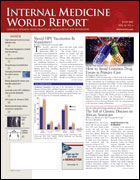Publication
Article
Internal Medicine World Report
The HPV Vaccine Opens a Pandora's Box
As is often the case in medicine, the introduction of the first therapeutic modality ever—whether in the form of the first drug/product or the first vaccine—for a certain disease elevates that disease from the depths of obscurity to a "celebrity" status. The launch of the first vaccine for human papillomavirus (HPV) infection is yet another demonstration of this phenomenon. A host of articles in this issue highlight the current debate and controversies surrounding this vaccine, which have granted it more than the "15 minutes of fame" à la Andy Warhol.
JAMA
But a sharper focus also invites greater scrutiny of the disease itself, which in this case has led to a puzzling situation. Data uncovered in a new study published in (Dunne, et al. Prevalence of HPV infection among females in the United States. 2007;297:813-919) and discussed in this issue suggest that previous information about the prevalence of HPV infection may be quite misleading. Specifically, although the prevalence of HPV among American women appears to be even greater than was previously thought, HPV types 16 and 18, the main targets of the vaccine, are actually quite uncommon in this country.
JAMA
This is indeed a disturbing development. Could the data published in be wrong? And if not, what does it mean to all the "noise" about mandating the vaccine, if in reality it will not cover most of the infections, and will even create a false sense of security? Some have already suggested that these new data will likely not change the current approach to the vaccine. This begs the question—Why?
As a mother of a 19-year-old college student who has just completed the 3-vaccine cycle, like many other parents probably, I find myself torn between amazement and disbelief.
Could we at least expect that this study will bring some sanity into our legislators' heads and stop the rush to a mandate that links the right for education to vaccination against a disease that is not transferrable by casual contact in school? This clash between politics and medicine is neither the first nor the last. It does crystallize some of the issues that have been raised often in this journal concerning the FDA's approval process, and perhaps even more about the methods of collecting the evidence in the first place.
And on a different topic—as a counterpoint to last month's In-Depth article on the potential threat of in-store clinics to primary care—at the annual meeting of the Society of General Internal Medicine (SGIM), a group of internists discussed the increasing role of home care in US healthcare. With the numbers of American elderly increasing, they suggest that the demand for home care is also rising, and this, they add, is going to be beneficial to physicians in financial terms as well as in clinical terms. In addition to being reimbursable, home visits afford physicians the opportunity to see certain patient behaviors with direct clinical ramifications that are not often observable in the office setting.
Another article from the SGIM focuses on chronic pain management in the elderly, highlighting what you could do to improve therapy for these patients and suggesting questions that should be addressed to patients directly to allow you to uncover a potential problem with drug dependence. Yet another article outlines a new program for pain management that is designed to ease physicians' discomfort with prescribing narcotics for pain.
IMWR
Finally, we are about to launch the first e-Newsletter, which will be sent to subscribers by request only. It will provide a quick preview of the upcoming issue and will enable you to read the articles directly on your computer even before you receive the issue at home. You will be able to opt out at any point.
Dalia Buffery, Group Editor






